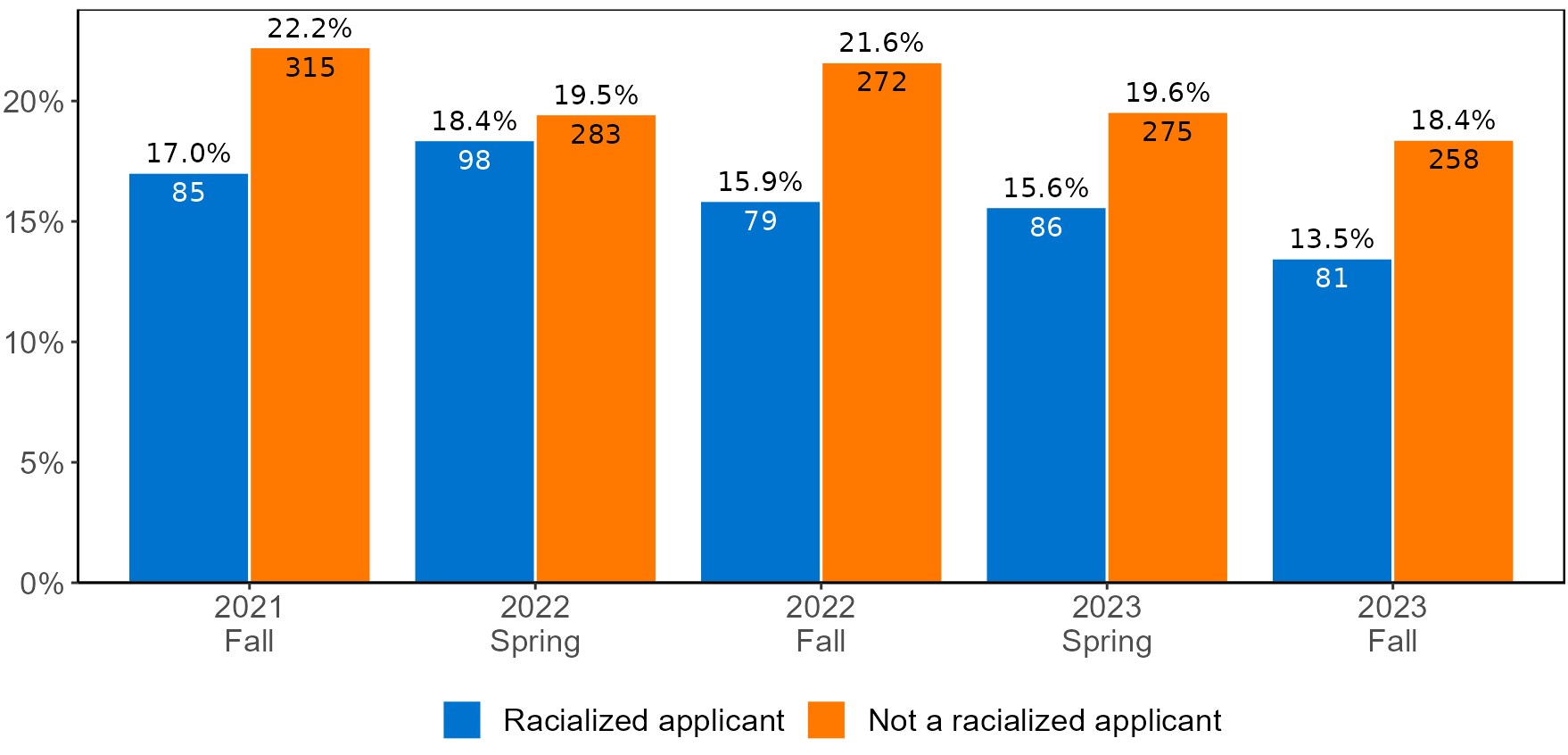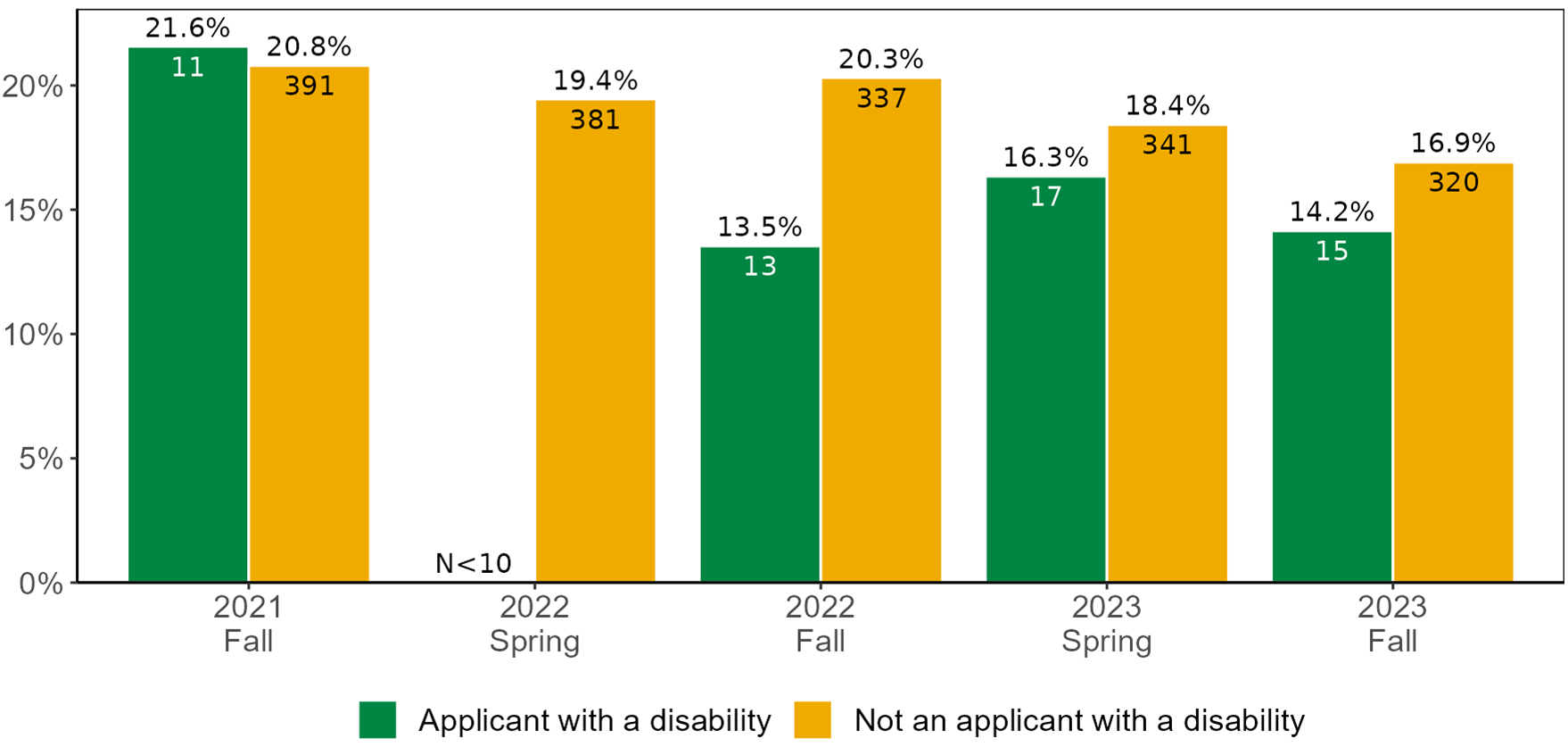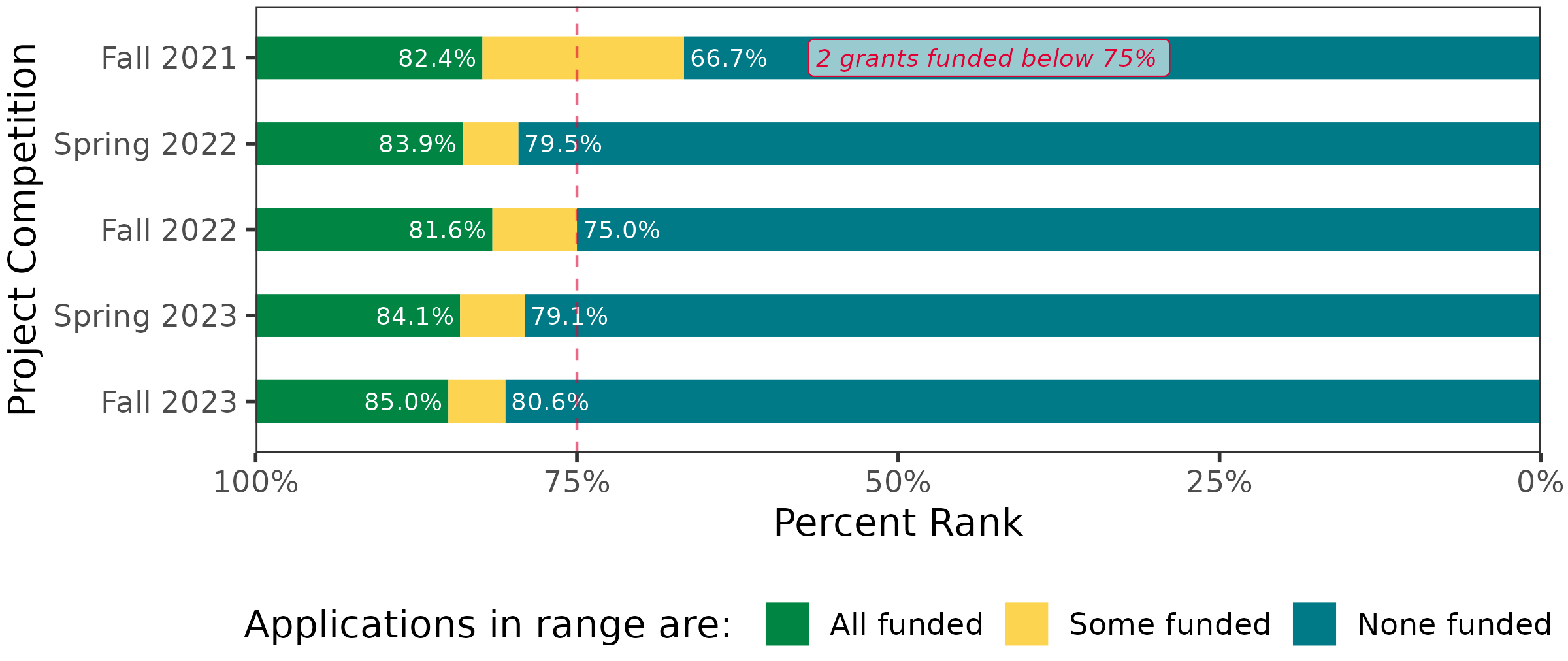Removing barriers to funding for racialized people and persons with a disability
Message from the Vice-President and Associate Vice-President, Research Programs (Operations)
Dear colleagues,
CIHR has been working to identify and address potential inequities in its funding system as part of our commitment to achieving a more equitable, diverse and inclusive Canadian health research enterprise.
Studies suggest that the quality of research increases when it is performed by diverse groups, as different life experiences add valuable perspectives to research projects and bolster trust among under-represented research participantsFootnote 1Footnote 2Footnote 3Footnote 4Footnote 5. This work aligns with the Government of Canada's commitments to anti-racism and accessibility in Canada, as well as the Tri-Agency EDI Action Plan.
By removing systemic barriers to accessing research funding, we enhance the participation and retention of outstanding researchers from under-represented groups and ensure we are supporting the full extent of Canada's scientific talent.
Adding new equalization measures to the Project Grant competition
We are pleased to announce that, starting with the Fall 2024 Project Grant competition, CIHR will equalize Project Grant applications from nominated principal investigators (NPIs) who self-identify as a racialized personFootnote 6 or who self-identify as a person with a disability. This equalization will ensure that the proportion of funded grants awarded to these groups is at least equal to the proportion of applications received from them. As you may know, CIHR already equalizes in the Project Grant program, when needed, for early career researcher NPIs, female NPIs and applications submitted in French. Learn more about how CIHR makes decision in the Project Grant program.
As a science-based agency, CIHR commits to continuously assessing its programs and making evidence-informed decisions. CIHR made the decision to expand equalization following careful analysis of Project Grant self-identification data over several years, which has revealed areas of concern specifically for racialized people and persons with a disability. Expanding equalization is also an action identified within CIHR's recently published Research Excellence Framework, which supports the agency's commitment to advancing a more inclusive concept of research excellence in all its diversity.
NPIs identifying as a racialized person have submitted 26% of applications (2,682) in the last five competitions but have received 21.9% of grants (429), which is 82 fewer than we would have expected based on their application pressure. NPIs identifying as a person with a disability have submitted 4% of applications (412) in the last five competitions but have received 3.2% of grants (62), which is 17 fewer than we would have expected based on their application pressure.
As such, we will use equalization as a first step toward reducing barriers to accessing funding experienced by members of these communities. This will be complemented by other actions to be detailed in the forthcoming CIHR Anti-Racism Action Plan and the CIHR Anti-Ableism Action Plan.
CIHR will continue to monitor the self-identification data received from applicants to our programs to inform any future interventions.
Data on applicants who self-identify as a racialized person
CIHR has collected data on applicants who self-identify as a racialized person since 2018. This group has consistently had a lower success rate than those who are not racialized. In the Fall 2023 Project Grant competition, those who self-identified as a racialized person had a success rate of 13.5% compared to 18.4% for those who did not.
Figure 1: Success rate - Racialized applicants

The percentage above the bar is the success rate. The number on the bar is the number of funded projects.
Figure 1 – Long Description
| Competition | Status | Number Funded | Success Rate |
|---|---|---|---|
| 2021 Fall | Racialized applicant | 85 | 17% |
| 2021 Fall | Not a racialized applicant | 315 | 22.2% |
| 2022 Spring | Racialized applicant | 98 | 18.4% |
| 2022 Spring | Not a racialized applicant | 283 | 19.5% |
| 2022 Fall | Racialized applicant | 79 | 15.9% |
| 2022 Fall | Not a racialized applicant | 272 | 21.6% |
| 2023 Spring | Racialized applicant | 86 | 15.6% |
| 2023 Spring | Not a racialized applicant | 275 | 19.6% |
| 2023 Fall | Racialized applicant | 81 | 13.5% |
| 2023 Fall | Not a racialized applicant | 258 | 18.4% |
Data on applicants who self-identify as a person with a disability
CIHR has collected data on applicants who self-identify as a person with a disability since 2018. Although the numbers are relatively small, there is a lower success rate trend for NPIs who self-identify as a person with a disability. In the Fall 2023 Project Grant competition, those who self-identified as a person with a disability had a success rate of 14.2% compared to 16.9% for those who did not self-identify as having a disability.
Figure 2: Success rate - Applicants with a disability

The percentage above the bar is the success rate. The number on the bar is the number of funded projects.
For privacy reasons, values calculated from fewer than 10 counts are suppressed when dealing with Self-ID Questionnaire data. Suppressed values are replaced with 'N<10'.
Figure 2 – Long Description
| Competition | Applicant type | Number Funded | Success Rate |
|---|---|---|---|
| 2021 Fall | Applicant with a disability | 11 | 21.6% |
| 2021 Fall | Not an applicant with a disability | 391 | 20.8% |
| 2022 Spring | Applicant with a disability | N<10 | N<10 |
| 2022 Spring | Not an applicant with a disability | 381 | 19.4% |
| 2022 Fall | Applicant with a disability | 13 | 13.5% |
| 2022 Fall | Not an applicant with a disability | 337 | 20.3% |
| 2023 Spring | Applicant with a disability | 17 | 16.3% |
| 2023 Spring | Not an applicant with a disability | 341 | 18.4% |
| 2023 Fall | Applicant with a disability | 15 | 14.2% |
| 2023 Fall | Not an applicant with a disability | 320 | 16.9% |
How equalization works
To make funding decisions in the Project Grant competition, CIHR needs to be able to compare results across peer review committees. To do this, scores for each application are converted to within-committee rankings, which are then used to calculate each application's percent rank. This allows CIHR to account for scoring differences across the committees, and it also allows us to fund an approximately proportional number of applications across each committee.
CIHR introduced equalization to ensure that all applications funded are scientifically meritorious based on the peer review process, while increasing representation from groups known to experience barriers within the health research funding system.
Equalization only impacts grants close to the funding cutoff. This means the highest ranked applications are always funded (i.e., in the last five competitions, the top 15% have been consistently funded—see green bar in graph below).
The yellow bar represents the zone where some grants may or may not be funded (i.e., in the last five competitions, this range has been between ~15% and 34%). The factors that impact the funding outcome for applications in this zone are equalization, ties within the committee, the large grant pool, and the number of applications in the committee. CIHR considers all applications in this zone to be scientifically meritorious based on the peer review process and there are no substantive differences in quality and impact between these applications, with some applications being separated by a score of 0.01.
Any application in the blue zone does not receive full-term grant fundingFootnote 7. CIHR's equalization policy aligns to some scientific literature, which suggests that reviewers can discern the strongest and most meritorious applications as well as the bottom/least meritorious applicationsFootnote 8Footnote 9.
CIHR has modelled the past five Project Grant competitions and has determined that we can almost always achieve equalization across all outlined dimensions (early career researcher NPIs, female NPIs, racialized NPIs, NPIs with a disability, and applications submitted in French) in every competition without impacting applications above 10% (i.e., all of these grants would still be funded) or below 25% (no grant with a ranking below this threshold would be funded).
CIHR will therefore establish the equalization zone as applications ranked outside the top 10% but within the top 25%. This means that the top 10% will always be funded and the bottom 75% will never receive full-term Project GrantsFootnote 10. CIHR funds applications in rank order from the top down as far as the competition budget will allow. In parallel, CIHR identifies which elements require equalization at a competition level and will intervene to ensure they are equalized to the extent possible within the 10-25% range. This ensures that all applications funded are scientifically meritorious based on the peer review process. It also allows CIHR to consider other factors amongst a group of applications that are scientifically meritorious, but where the quality of the applications is not materially different. We acknowledge that it may not be possible in all competitions to fully equalize certain dimensions based on these parameters. CIHR will transparently publish equalization data in its funding decisions.
As this intervention is based on the Tri-Agency Self-Identification Questionnaire, it relies on the integrity and honesty of applicants. CIHR takes this very seriously. By accepting and using the grant funds, the applicant is attesting to CIHR that the self-identification responses they provided were accurate.
Existing equalization impact over the last five Project Grant competitions
Figure 3: Current (ECR, Female, and French)

IHR, Large Grant and streamlined applications are not included in these data.
Figure 3 – Long Description
| Competition | All funded cut-off | Some funded cut-off | Number funded below 75% |
|---|---|---|---|
| Fall 2021 | 82.4% | 66.7% | 2 |
| Spring 2022 | 83.9% | 79.5% | 0 |
| Fall 2022 | 81.6% | 75.0% | 0 |
| Spring 2023 | 84.1% | 79.1% | 0 |
| Fall 2023 | 85.0% | 80.6% | 0 |
Expanded equalization impact modelled onto the last five Project Grant competitions
Figure 4: Current + Racialized applicants + Applicants with a disability

IHR, Large Grant and streamlined applications are not included in these data.
Figure 4 – Long Description
| Competition | All funded cut-off | Some funded cut-off | Number funded below 75% |
|---|---|---|---|
| Fall 2021 | 83.9% | 66.7% | 2 |
| Spring 2022 | 84.8% | 70.0% | 5 |
| Fall 2022 | 83.3% | 74.3% | 1 |
| Spring 2023 | 85.7% | 79.1% | 0 |
| Fall 2023 | 87.2% | 80.0% | 0 |
In closing, we wish to reiterate that CIHR is committed to achieving a more equitable, diverse and inclusive Canadian research enterprise and we recognize there is more work to be done. Thank you to all those who have volunteered their time to advise CIHR in the areas of anti-racism and anti-ableism, as well as those who support the Project Grant program, including committee Chairs, Scientific Officers and peer reviewers.
If you have any questions about this or any other topic, I invite you to reach out to CIHR's Contact Centre at support-soutien@cihr-irsc.gc.ca, or get in touch with your CIHR University Delegate, who can bring your question forward to us.
Sincerely,
Dr. Christian Baron
Vice-President, Research – Programs
Adrian Mota
Associate Vice-President, Research – Programs (Operations)
- Date modified: